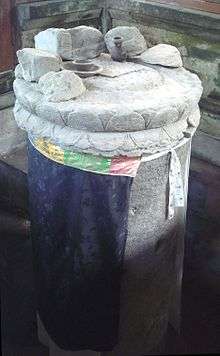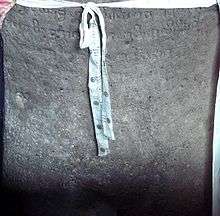Belanjong pillar
| Belanjong pillar | |
|---|---|
 The Belanjong pillar in Sanur dates to 914 CE, testifies to the contacts between Bali, Java and the Indian subcontinent. | |
| Material | Andesite stone |
| Writing | Pranagari script in Sanskrit and Old Balinese |
| Created | 914 CE |
| Discovered | Belanjong, southern Sanur in Bali, Indonesia |
| Present location | In situ (original location) |
The Belanjong pillar, also Blanjong pillar or Blanjong inscription (Indonesian: Prasasti Blanjong), is a pillar established in 914 CE in the harbour of Belanjong, in the southern area of Sanur in Bali.
The pillar was established by king Sri Kesari Warmadewa, the first king of the Balinese Warmadewa dynasty and bears a long inscription where the king describes his military campaign in the island. It is located in the Belanjong (Blanjong) Temple, where it is housed under a protective enclosure, and is often decorated and partially covered with devotional cloth.
The inscription is written in both the Indian Sanskrit language and Old Balinese language, using two scripts, the Nagari script and the Old Balinese script (which is used to write both Balinese and Sanskrit).[1] The Old Balinese in pre-Nagari script in on one side of the pillar, while the Sanskrit inscription in Pallava-derived old Javanese script (also called Kawi script)[2] is on the other side.[3] The mix of language and script suggest that the objective of the inscription was not to communicate locally to the Balinese people, but rather to be established as a symbol of power and authority.[2]
The pillar testifies to the connections of Bali with the Sanjaya Dynasty in Central Java.[4] According to the inscription, Sri Kesari was a Buddhist king of the Sailendra Dynasty leading a military expedition,[5] to establish a Mahayana Buddhist government in Bali.[6] The inscription also tells about the success of military expeditions of offshore islands, either Nusa Penida or faraway Maluku.[2] This is the first known inscription in which a Balinese king recorded his name.[3]
Two other inscription by Kesari are known in the interior Bali, which suggest conflicts in the mountainous interior of the island.[2]
The pillar is dated according to the Indian Saka calendar, in the year 836 saka.[7]
According to French historian George Coedès:
"These inscriptions reveal a Hindu-Balinese society, independent of Java, making use of a dialect particular to the island, and practicing Hinduism and Buddhism at the same time."
— George Coedès.[2]
The pillar was only discovered in 1932,[8] and has remained where it was initially found.
 Part of the inscription on the top of the pillar.
Part of the inscription on the top of the pillar. The alley leading to the Belanjong pillar in Belanjong temple.
The alley leading to the Belanjong pillar in Belanjong temple. Protective enclosure for the Belanjong pillar, in Belanjong temple.
Protective enclosure for the Belanjong pillar, in Belanjong temple.
See also
Notes
- ↑ Haer, p. 275
- 1 2 3 4 5 A short history of Bali by Robert Pringle p. 46
- 1 2 The people of Bali Angela Hobart p. 141
- ↑ Andy Barski, Albert Beaucort and Bruce Carpenter, Barski (2007). Bali and Lombok. Dorling Kindersley, London. ISBN 978-0-7566-2878-9. p. 45
- ↑ Bali handbook with Lombok and the Eastern Isles by Liz Capaldi, Joshua Eliot p. 98
- ↑ Bali & Lombok Lesley Reader, Lucy Ridout p. 156
- ↑ The people of Bali Angela Hobart p. 24
- ↑ Bali handbook with Lombok and the Eastern Isles Liz Capaldi, p. 98